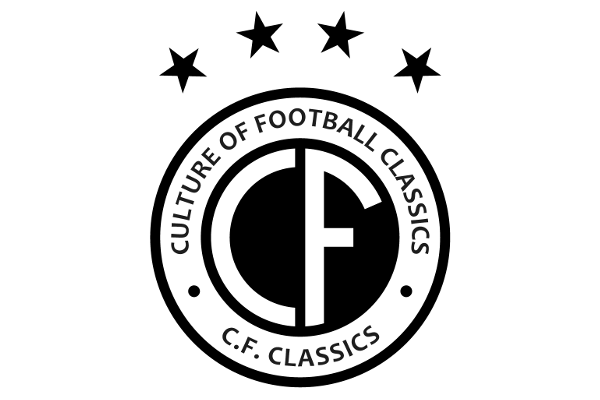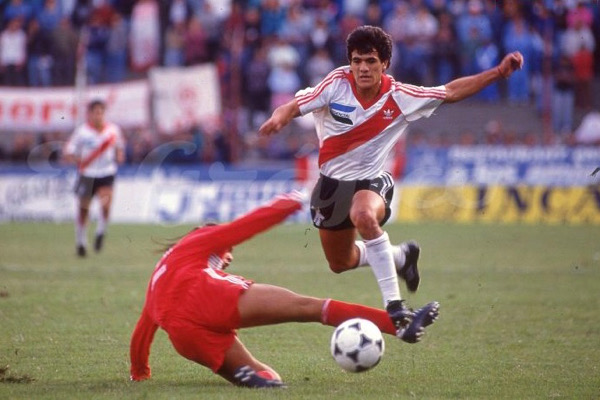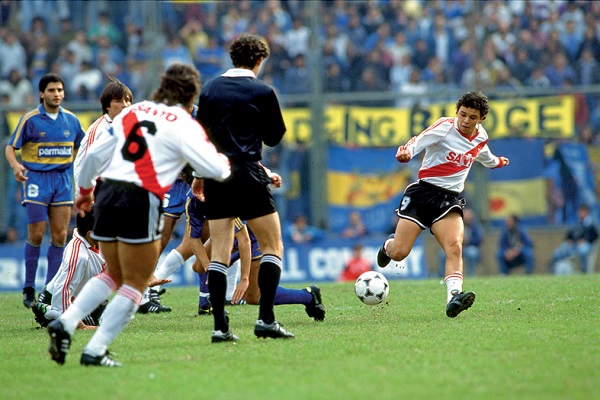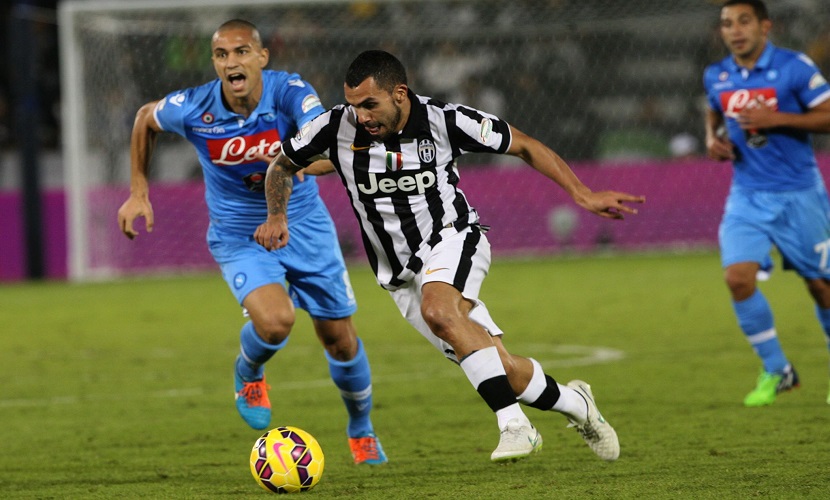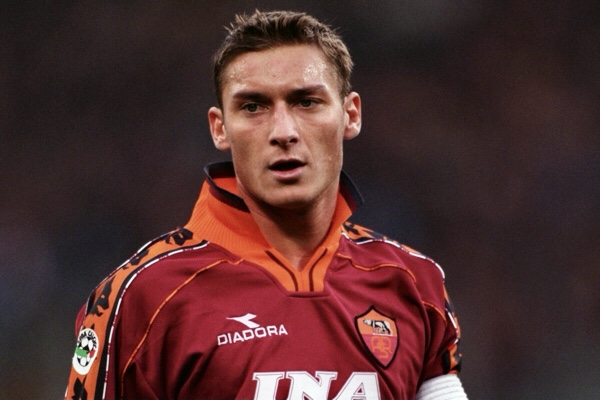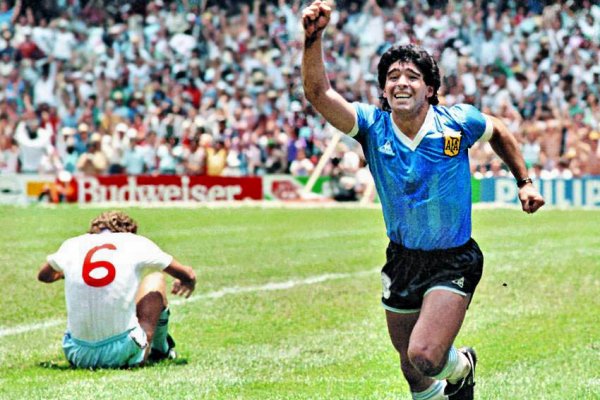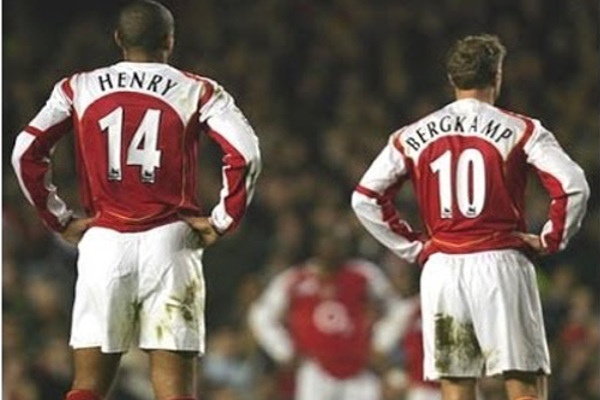The Next Maradonas
A lot of players suffered because of the New Maradona tag. They were quality players in their own right but when hyped up before a tournament as the New Maradona, impressionable youngsters like us expected them to be doing all of the stuff Diego Maradona was doing. They all showed glimpses of magic but only one player has come close since, and that is why we will probably have a future list known as the New Messi.
Diego Latorre Career: 1987-2006
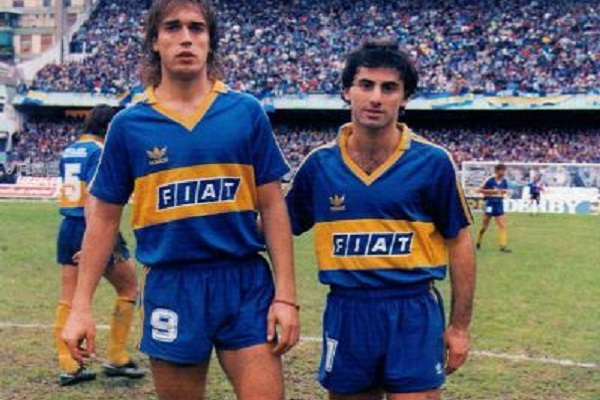
Diego Latorre with Batistuta at Boca Juniors in 1991.
Photo: Wikimedia Commons
The first player to be labelled as the New Maradona was, appropriately, another Diego. And one with links to Boca Juniors. Diego Latorre. Latorre could play up front or as attacking midfielder. He'd shown some great form for Boca since making his debut as an 18 year old in 1987. When the Copa America tournament came around in 1991, Maradona was unavailable for the Argentinian squad because he'd been suspended from football after failing a drug test in the Italian Serie A. New national team coach Alfio Basile was needing a replacement and Latorre got the nod, he'd struck up a fine partnership at Boca Juniors with another talented youngster, Gabriel Batistuta. Despite Argentina winning the tournament for the first time in 32 years, it was a 'sliding doors' moment for both players. Whilst Batistuta had an incredible run of games, finishing as the tournaments top-scorer, Latorre struggled to make an impact. Legend has it that Latorre had signed for Fiorentina before the tournament, but whilst watching the matches to see how he got on, La Viola's hierarchy suddenly turned their attention to Batistuta and decided he was the player they wanted more than anything. The rest is history, as Batistuta went on to become an absolute legend in Serie A, whilst Latorre ended up at Spanish clubs Tenerife and Salamanca, before returning to Boca Juniors in 1996.
Ariel Ortega Career: 1991-2012
Whilst Diego Latorre is widely believed to have been the first player to be labelled the New Maradona, it was Ariel Ortega who initially carried the real burden of the tag over the course of a number of years. Maradona's failed drug test at the 1994 World Cup had signalled the end of his international career and meant that, for the first time since 1978 when Mario Kempes wore the jersey, La Albiceleste would go into the 1998 World Cup with someone other than Diego Maradona wearing their iconic number 10 shirt. Ortega was the obvious candidate and got the nod. His form at River Plate in the 1990s had been fantastic and had lead to a transfer to Valencia, followed by a big money move to Serie A club Sampdoria, replacing fellow countryman Juan Sebastián Verón who'd made his own big money move to Parma. There was a lot of publicity around Ortega, and even more expectation. He didn't dominate the Argentinians first round matches like Maradona, but he did show glimpses of his undoubted talent and the Argentinians continued to have high hopes as they progressed past England into the quarter finals. It all ended on a sour note though, as Ortega ended up being remembered for his sending-off against the Netherlands as he head-butted Edwin van der Sar, rather than any glorious footballing moment. If the Argentinian F.A. had their way, then Ortega would have been the last player to wear it as well, as they tried to retire the shirt in honour of Maradona before the 2002 World Cup, but FIFA banned them from doing so.
Marcelo Gallardo Career: 1993-2011
Having played second fiddle to the likes of Ariel Ortega and Enzo Francescoli in that fine River Plate team of the mid-1990s, Marcelo Gallardo finally came into his own as the team's playmaker in the late 1990s. He was capable of great moments of skill and had terrific ball control, but Gallardo's finest attributes were undoubtedly his passing, vision, and intelligence on the ball. He was one of those rare players who could dictate his team's tempo, stitching all the play together and then splitting the opposition's defence with a killer-pass. It was this creativity that saw him operate mainly as an attacking midfielder or occasionally a central midfielder.
Gallardo would go on to have a decent spell in France with Monaco and Paris Saint-Germain but would return back for spells at his beloved River Plate after playing for each of them.
Juan Román Riquelme Career: 1996-2014
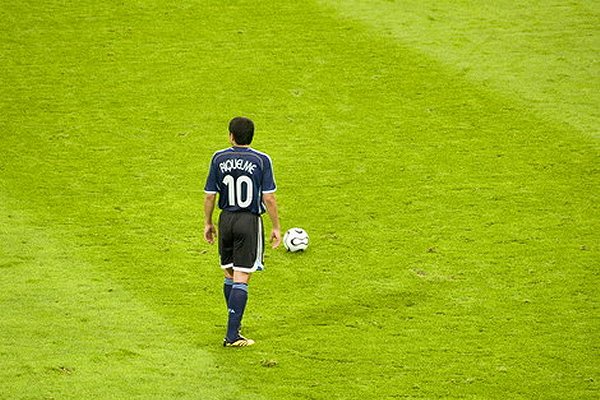
Juan Román Riquelme, playing for Argentina at the 2006 World Cup.
Photo: Wikimedia Commons
A classic number 10, who had similarities to Maradona off the pitch, as well as on it, Juan Román Riquelme always going to be labelled as a New Maradona. Born into a poor family on the outskirts of Buenos Aires, his early career followed a similar path to Maradona's - starting out in the youth team of Argentinos Juniors before signing for Boca Juniors. And then, remarkably, 20 years after Maradona had moved from Boca Juniors to Barcelona, Juan Román Riquelme made exactly the same move, swapping La Bombonera for the Camp Nou in 2002. His skills were now expected to be appreciated by a wider audience, but as with Diego's move back in 1982, things didn't work out as planned, and Juan Román Riquelme would have to leave Barcelona before he hit top form on European soil. Whilst Diego would leave Spain and head to Napoli in Italy, Juan Román Riquelme would stay in Spain, joining Villarreal on a two-year loand deal before making the move permanent. Like Maradona, he would eventually end up back at Boca Juniors, yet whilst Maradona's would be a fleeting couple of seasons at the very of his career, Juan Román Riquelme would make his return whilst he was still in his prime, aged 29, and continue to weave his magic for seven more years before ending his career back where he'd started as a youth player, at Argentinos Juniors.
Pablo Aimar Career: 1996-2015
Ridiculously talented, oozing skill and class, Aimar's vision, invention and passing made him a classic Argentinian number 10, attributes that would see him become one of the finest attacking midfielders of the late 1990s and 2000s. If it wasn't for a series of bad injuries then who knows what Aimar could have achieved in the game.
Javier Saviola Career: 1998-2016
Another incredible young Argentinian talent who burst onto the scene in the late 1990s. And whilst Maradona had made his name at Argentinos Juniors and then Boca Juniors, Saviola became the boy wonder at rivals River Plate, making his debut for the club as a 16 year-old and quickly establishing himself with a series of stunning performances for Los Millonarios. skill, invention, trickery, but Saviola also really knew where the back of the net was Indeed, by 1999 Saviola had made the similarities to Maradona by breaking his record as the youngest ever winner of the Argentinian Golden Boot award, his 15 goals in 18 matches in the 1999 Apertura championship making the football world sit up and take notice, the season topped off as he was also named the South American Footballer of the Year as well.
The inevitable move to Europe followed a few years later, Barcelona bringing him to the Camp Nou and hoping that the move would be more successful than when they bought a young Diego 19 years earlier. However, despite scoring 17 goals in his first season and scoring some fine goals, he never hit the heights that everyone expected, and his subsequent career at various clubs in Europe in the coming years would follow a similar theme - still scoring, still looking dangerous, but not getting the consistency that would make him one of the world's very best.
Carlos Marinelli Career: 1999-2014
Slightly different to the others in our list, as Marinelli was dubbed the new Maradona by the English press, rather than by the Argentinians themselves. Marinelli had started his youth career with Argentinos Juniors, before being snapped up by Boca Juniors, so the obvious links to the great man himself were there. But when Bryan Robson signed him for Middlesbrough in 1999, Marinelli only had one appearance for Boca's reserve team to his name, and hadn't had a sniff of the first team. South American signings were still quite a rarity for English clubs at the time, so the idea that Boro might have snapped up a great attacking prospect sent the local media into overdrive, and nearly 10,000 fans turned up to watch his debut for the reserves. However, Marinelli didn't live up to the hype and went out on loan to Torino in 2003 before heading back to Argentina.
Andres D'Alessandro Career: 2000-2021
At the turn of the century it was time for another River Plate starlet to become the centre of attention as the country's conveyor belt of talent produced yet more attacking prospects. D'Alessandro had joined River Plate as a ten year-old and worked his way through the youth system. An attacking midfielder with great dribbling ability and an array of tricks, he made his debut as an 18 year old in 1999 but really came to the fore in 2001, completely establishing himself in the first team and starring at FIFA's World Youth Championships as Argentina won the title on home soil, D'Allesandro and River Plate team-mate Javier Saviola winning the individual awards as the tournament's best players. His form would see him tagged as a potential heir to Maradona's no.10 shirt by both the media and by Maradona himself, and it wasn't long before Europe came knocking, Wolfsburg paying a club record €9 million for him in 2003. But like the others before him, he'd fail to live up to the high expectations Despite not living up to the hype, he'd still carve out a decent career, culminating in being named Souuth American Footballer of the Year in 2010 after helping Internacional win the Copa Libertadores
Carlos Tevez Career: 2001-2021
Sergio Aguero Career: 2003-2021
Looking at how prolific Sergio Agüero became during his incredible ten years at Manchester City, becoming thought of as an out-and-out striker, it seems strange to think that he would have been considered as an heir to Maradona, with the great man operating deeper. However, as a youngster at the start of his career Agüero wasn't viewed as a striker, so during his time with Independiente and then Atlético Madrid, he was seen more as a creative second-striker, forming a particularly fine partnership at the Vicente Calderón Stadium with Diego Forlan, Agüero's skill and vision proving a great foil for the Uruguayan forward. So it's possible to see in these early days why the Argentinian press would view him as one of their next big hopes, but their was another link to the great man as well - Agüero had married Giannina Maradona, Diego's youngest daughter, and he was even there for the birth of their first son in Madrid.
Ezequiel Lavezzi Career: 2003-2019
Lionel Messi Career: 2003-2021
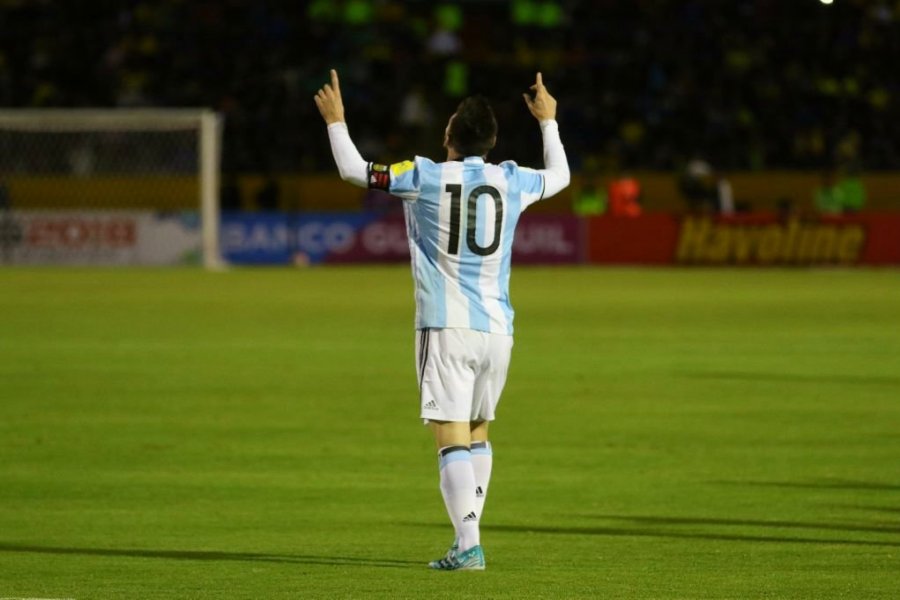
Lionel Messi.
Photo: Wikimedia Commons / Agencia de Noticias ANDES.
Given Messi's incredible talent as a youngster at Barcelona, it was inevitable that he would be declared as the new Maradona. Obviously he has subsequently gone on to forge his own incredible legacy, with the sort of goal-scoring and assist statistics that almost defy belief and lead to discussions about where he stands in the list of all-time footballing greats. Given the level that Messi has reached, we'll make him the last of the next Maradonas, as the next generation of Argentinian talent will probably be tagged as the new Messi once this particular legend hangs up his boots.
Tweet
